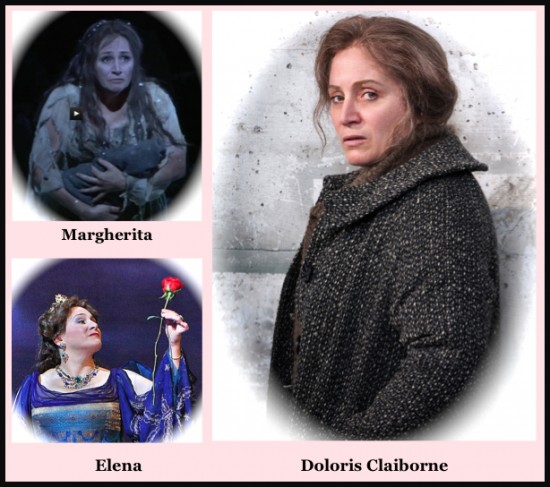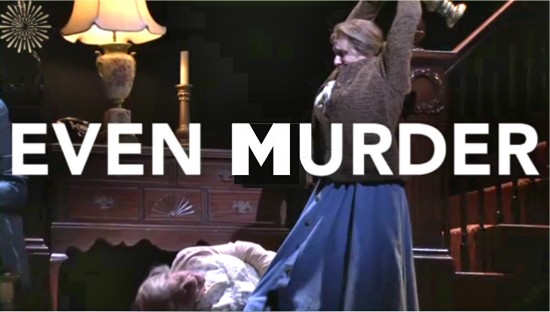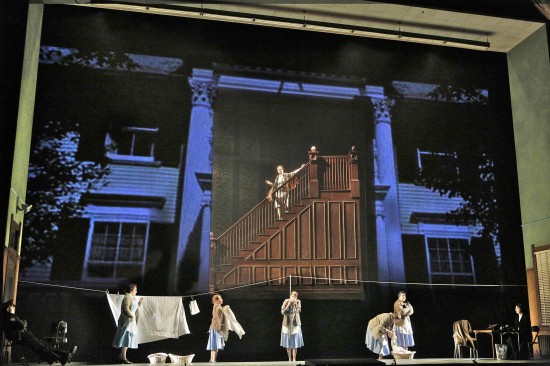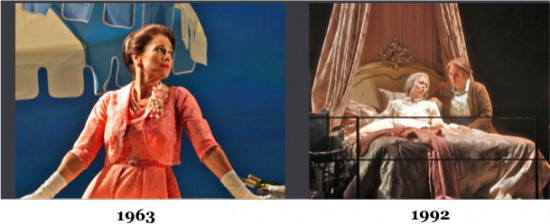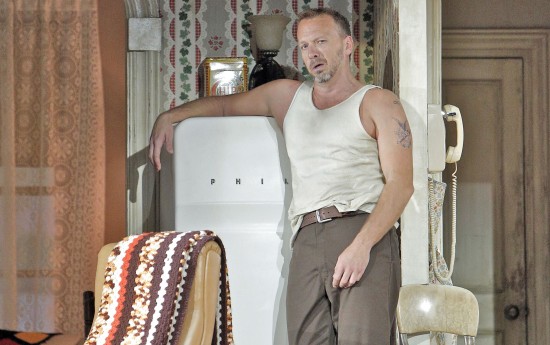Dolores Claiborne is unforgettable.
Dolores Claiborne is the title of a novel by Stephen King. I have never read the novel, but I understand that it is unique among his novels in that it does not contain any supernatural phenomena or any undue gore.
Dolores Claiborne is the title of a movie strongly based on that novel. I have never seen the movie, but I understand that it is a bit lighter than the novel.
Dolores Claiborne is the name of an opera with music by Tobias Picker and words by J. D. McClatchy, whose World Premiere performance was by the San Francisco Opera on September 18, 2013. I have just seen the second performance on September 21 and am still reeling from its impact. I understand that it is even darker than the novel.
Dolores Claiborne is the title character of both the novel and the movie. According to the program, the role of Dolores Claiborne was played by Patricia Racette, but you can’t fool me. The woman who walked into her dressing room before the opera may well have been Patricia Racette, but the woman who walked on stage Sunday afternoon was Dolores Claiborne – no way could she have been the woman I saw earlier this month as Margherita (and as Elena) in Boito’s Mefistofele.
Before I go any further, if you don’t already have a ticket, waste no time in getting one (San Francisco Fall 2013). There are only a few performances left before the show closes on October 4 – and the final appearance of Patricia Racette will be on September 28. And when you go, be sure to get there an hour early for the pre-opera talk. Normally these talks are formal lectures with recorded musical inserts, but for Dolores Claiborne they are interviews with the composer Tobias Picker, who is a most articulate speaker.
The story of Dolores Claiborne is told in a non-linear series of episodes – and the first one is really an attention grabber:
“Winter 1992: The grand staircase of Vera Donavan’s manor house on Little Tall Island, off the coast of Maine. Vera lies at the bottom of the stairs. Dolores Claiborne, her maid and housekeeper for forty years, is standing with an object raised over Vera. A young woman enters and screams, �Mother!’“
After a short, discordant, and foreboding overture, the orchestra is silent as the curtain rises to a tableau that is held for what seems like an interminable beat. The woman screams. The stage blacks out. The orchestra echoes the scream and resumes play as the lights go on again for episode 2 in an interrogation room the next day. The picture above is actually a video clip from the promotional trailer. The actual scene shows the entire staircase and does not include the “EVEN MURDER” banner. The quote is the complete synopsis of the first episode as it appears on page 38 of the program.
The entire production was gripping, and credit belongs to the entire opera company, starting with San Francisco Opera General Director David Gockley (seated R) who commissioned the opera. In addition to the composer, librettist, orchestra, and singers (of whom more later), I single out set designer Allen Moyer (seated L), costume designer James Schuette, director James Robinson, projection designer Greg Emetaz (standing L to R), and lighting Designer Christopher Akerlind (not shown).
The timeline was distinctly non-linear. The opening tableau was on a winter day, 1992 – let’s call that “now”. Most of the following scenes are flashbacks to various dates between 1950 and 1963 and not always in chronological order. However, about half a dozen scenes jump forward to a new “now” covering about the next week – these too are not always in order. At first glance the effect was jerky and sometimes confusing. But the underlying picture of the whole opera was a highly dysfunctional family whose lives were jerky and sometimes confusing. The same two words could be applied to the music and some of the dialog. It all fit together into a powerful whole.
The stage setting was remarkable, both for its stunning effect and for the ease with which it could be changed. Typically it consisted of up to three parts: the back scrim showing projected pictures (video or still), the upstage raised about 6 feet above stage level, and the stage-level downstage. Any of these parts could be further subdivided by standard lighting techniques.
These divisions might further emphasize the dysfunction theme. For example, as shown in the above picture, the scrim shows the exterior of Vera Donovan’s house, darkened and blued as if seen by moonlight; upstage shows the central hall in the interior of the house; most of stage level is the backyard in full sunlight. Further, although all of above are in 1950, both corners of downstage and not highlighted are from the police station interrogation room of the local police station in 1992.
Midway through Act I is a lengthy scene on the deck of the Little Tall Island Ferry. No separate upstage for this scene, and the scrim shows a seascape moving from right to left to give the impression that the ferry is moving from left to right. The main part of the scene is a conversation between Dolores Claiborne (Patricia Racette) and her daughter Selena St. George (Susannah Biller). However, before we see either of them, we see and hear two characters identified in the program only as “Teenage Boy” (Hadleigh Adams) and “Teenage Girl” (Nikki Einfeld). He is coming on strong to her – she protests at first – he comes on again – she acquiesces – they head off stage looking for a more secluded bench and apparently ready to assume a horizontal position. We never hear from them again. I interpreted this as a subtle flashback to the conception of Selena, some 18 years previously.
The music. From as far back as I remember I have loved classical music: Mozart, Beethoven, Brahms, Dvorak, Tchaikovsky, etc. I easily expanded my love to Sibelius and Prokofiev. As I discovered opera, I loved the music of Donizetti, Rossini, Verdi, Puccini, Wagner. But, try as I may, I just can’t take the next step to music of the more modern composers. Paradoxical as I may seem, I thoroughly enjoy many of the operas they write. It’s a matter of semantics. I just regard the notes written by Tobias Picker as instructions to the actors and instrumentalists for producing sounds that enhance and amplify their playing. The relationship between Picker’s music and the story of Dolores Claiborne is analogous to the relationship between a modern impressionist painting and the physical object named in its title. By itself, I don’t much care for it; as an ingredient of the whole production, it is an indispensable element.
The words by J. D. McClatchy fit the music like a glove, and greatly enhance the sordid tragedy. Particularly chilling is Joe St. George’s ditty when he molests his daughter Selena with the enforced invitation to “Let’s play our little game – Daddy go up, Daddy go down, Daddy go into the well.” In another scene, Vera has just confided to Dolores Claiborne that she, too, had suffered from an abusive husband and suggests that “Accidents can be a woman’s best friend.” In the middle of Act II, Dolores Claiborne has just finished her trap to catch and kill her husband. She muses, “I hope God wasn’t looking. I know He won’t forgive me. God don’t have time to forgive women. He’s too busy forgiving men.” Brrrr.

Selena (Susannah Biller), Detective Thibodeau (George Fedderly), Doris Claiborne (Patricia Racette), and the Court Stenographer (supernumerary)
Then there’s the cast – stars, soloists, chorus, supernumeraries, stage hands – every person who appeared on that stage was wholly committed to her-or-his role and played it to perfection.
Susannah Biller did an amazing job portraying the very complex role of Selena. I have no conception of the life she was forced to live – the tortured teenager trying in vain to reconcile the reality of Joe’s evil actions with an unspoken desire to love him as her father. Possibly she ended up feeling that somehow it was all her mother’s fault – how could she forgive Dolores for murdering him? Sublimating the conflict by studying and working obsessively hard to become a crack New York City attorney, but an unfilled 45-year old woman. Ms Biller did it all, and with a beautiful soprano voice. Hard to believe this was the same singer as the irrepressible Despina in last spring’s Cosi Fan Tutte.
Tenor George Fedderly sang the role of Detective Thibodeau with just the right mixture of bluster, compassion, and horror that anyone should murder the elderly, helpless Vera.
Soprano Elizabeth Futral sang her two roles as the wealthy widow Vera Donovan with beauty and precision. I say “two” because in Act I she is a totally confident society matron, patronizing to both servants and guests, whereas in Act II she is a querulous, somewhat demented old woman, wanting only to die.
Joe St. George is not the least complex. He is evil – pure unadulterated evil. He sexually abuses his daughter. He hits his wife with a stick of firewood and calls her ugly. He steals his wife’s life savings and spends it on gin. He is dirty, slovenly, and cowardly. He picks up an axe, strums it like a guitar, and sings, “Ain’t nobody gonna tell Joe St. George what to do.”
I’m sure that Wayne Tigges is not the least bit like that in real life, but somehow when he stepped on that stage he convinced me that he really was that disgusting person. In the standing applause received by the entire cast, his bow received an increased level of clapping and many shouts of “Bravo” together with a substantial chorus of “Boo’s” – the latter obviously meant for Joe and the former for Wayne.
Ian Robertson probably had a smaller job this week than last week with Mefistofele, since the chorus here had only a background role. On the other hand, the music was probably more difficult. Anyhow, tough or easy, he and his chorus did it to perfection, as usual.
Dolores Claiborne was George Manahan’s debut with SFOpera, but he has previously been seen in guest appearances in many European cities and in a large number in this country. He has a major commitment to working with young musicians, and specializes in conducting modern composers. He is no stranger to Tobias Picker, having conducted the composer’s opera Emmeline. He had perfect control of the orchestra and made sure that no matter how jerky and confusing the score and the libretto, there was no internal dysfunction within the musical community of singers and instruments – discords, yes, as written – dysfunction, never.
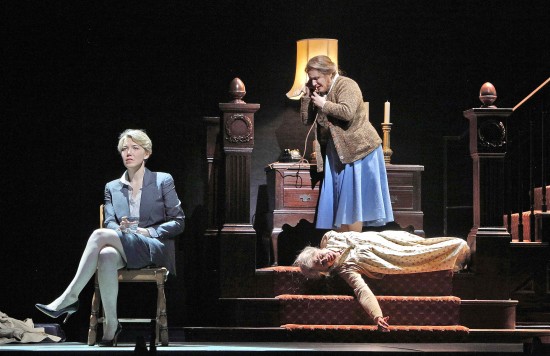
(L) Selena in Dolores’ abandoned home; (R) Flashback to night of Vera’s death: Dolores and Vera’s dead body
Final episode: Daughter and mother meet in Dolores Claiborne’s abandoned home the day after Detective Thibodeau has let her go free for lack of evidence. Selena asks, “Mother, what really happened that night?” A flashback scene appears at the right showing the stair landing as shown above, the full staircase, and Vera’s bedroom on the second floor as shown in an earlier picture. Dolores Claiborne steps out of the present and into Vera’s bedroom. The synopsis describes it thus: “Vera makes a shocking confession and a desperate plea, and we see events as they unfolded that fateful night.”
That mystery solved, Dolores Claiborne steps back into the present. Mother and daughter sit side by side and wonder about their future. A tacit decision is made. Selena leaves. Doris Claiborne sits alone as the lights slowly fade into final slow blackout.
PERFORMANCES
Wed 09/18/13 7:30pm
Sun 09/22/13 2:00pm
Wed 09 25/13 7:30pm
Sat 09/28/13 8:00pm
Tue 10/01/13 8:00pm
Fri 10/4/13 8:00pm
San Francisco Opera
301 Van Ness Avenue
San Francisco, CA 94102
(415) 861-4008
sfopera.com
Except as noted, all photos by Cory Weaver, San Francisco Opera
Cropping and arrangements by Philip Hodge
Quotes in italics are from the synopsis on page 38 of the program
This review by Philip G Hodge appeared in sanfranciscosplash.com on September 26, 2013.


